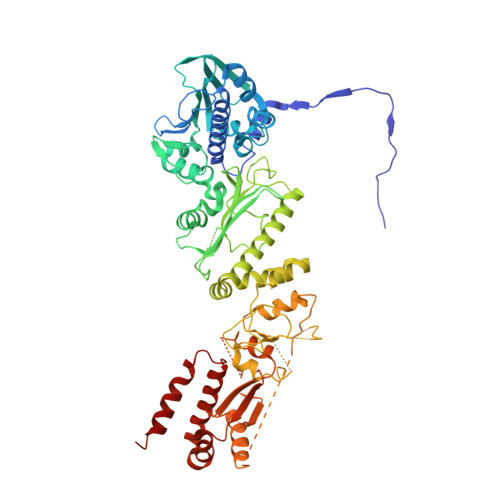Calcium binding to a remote site can replace magnesium as cofactor for mitochondrial Hsp90 (TRAP1) ATPase activity.
Elnatan, D., Agard, D.A.(2018) J Biol Chem 293: 13717-13724
- PubMed: 29991590
- DOI: https://doi.org/10.1074/jbc.RA118.003562
- Primary Citation of Related Structures:
6D14 - PubMed Abstract:
The Hsp90 molecular chaperones are ATP-dependent enzymes that maintain protein homeostasis and regulate many essential cellular processes. Higher eukaryotes have organelle-specific Hsp90 paralogs that are adapted to each subcellular environment. The mitochondrial Hsp90, TNF receptor-associated protein 1 (TRAP1), supports the folding and activity of electron transport components and is increasingly appreciated as a critical player in mitochondrial signaling. Calcium plays a well-known and important regulatory role in mitochondria where it can accumulate to much higher concentrations than in the cytoplasm. Surprisingly, we found here that calcium can replace magnesium, the essential enzymatic cofactor, to support TRAP1 ATPase activity. Anomalous X-ray diffraction experiments revealed a calcium-binding site within the TRAP1 nucleotide-binding pocket located near the ATP α-phosphate and completely distinct from the magnesium-binding site adjacent to the β- and γ-phosphates. In the presence of magnesium, ATP hydrolysis by TRAP1, as with other Hsp90s, was noncooperative, whereas calcium binding resulted in cooperative hydrolysis by the two protomers within the Hsp90 dimer. The structural data suggested a mechanism for this cooperative behavior. Because of the cooperativity, at high ATP concentrations, ATPase activity was higher with calcium, whereas the converse was observed at low ATP concentrations. Integrating these observations, we propose a model in which the divalent cation choice can control switching between noncooperative and cooperative TRAP1 ATPase mechanisms in response to varying ATP concentrations. This switching may facilitate coordination between cellular energetics, mitochondrial signaling, and protein homeostasis via alterations in the TRAP1 ATP-driven cycle and its consequent effects on different mitochondrial clients.
Organizational Affiliation:
From the Howard Hughes Medical Institute and the Department of Biochemistry and Biophysics, University of California at San Francisco, San Francisco, California 94158-2517.
















